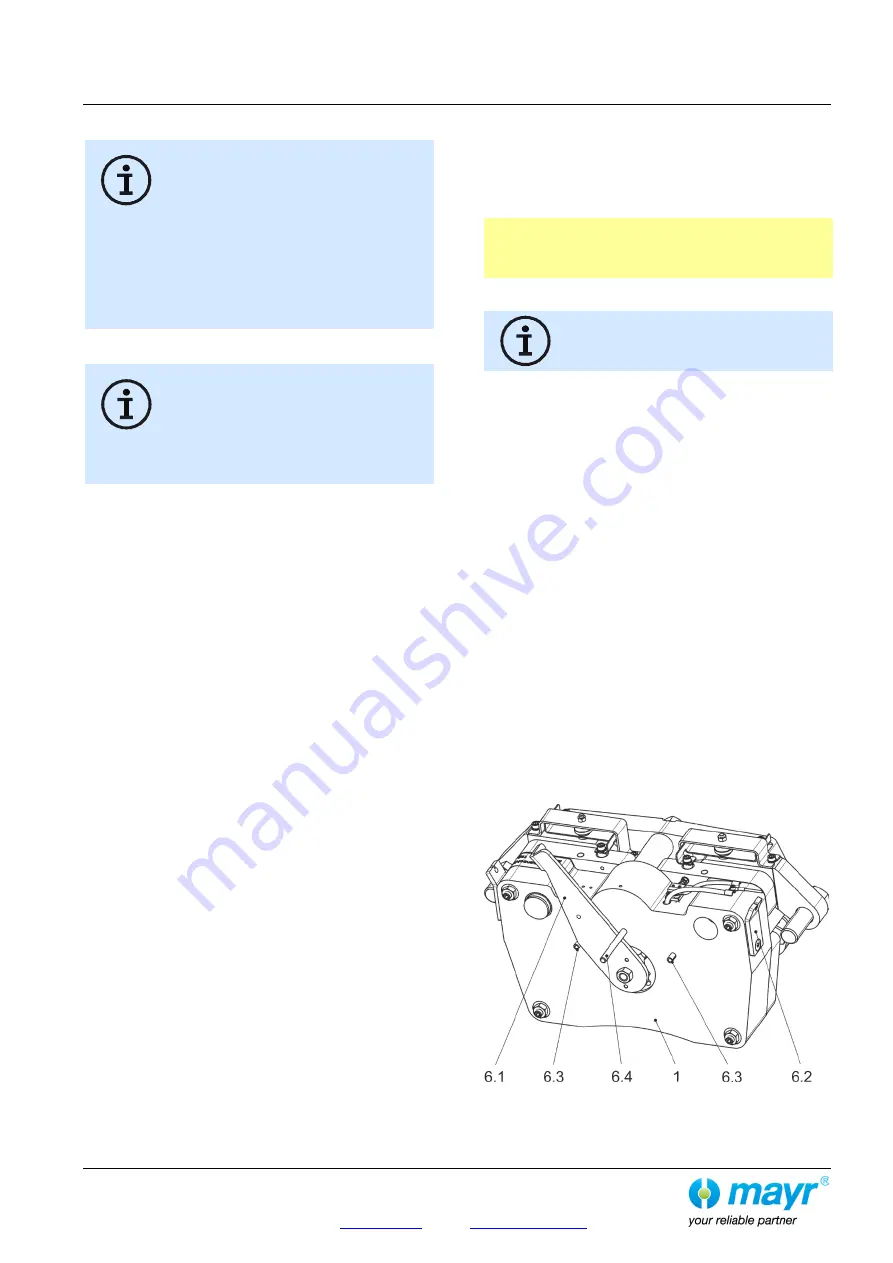
Installation and Operational Instructions for ROBA
®
-diskstop
®
Type 894.5_ _._ _ Sizes 9 and 10
(B.8.4.5.EN)
27/08/2020 TK/TL/GC/SU
Chr. Mayr GmbH + Co. KG
Eichenstraße 1, D-87665 Mauerstetten, Germany
Phone: +49 8341 804-0, Fax: +49 8341 804-421
Page 12 of 17
, E-Mail:
Adjustment
The brakes are equipped manufacturer-side with
the respective springs for the braking force
stated on the Type tag. Adjustment is not
necessary. Adaptions or modifications are not
permitted as a rule. This rule also applies to the
manufacturer-side adjusted noise damping.
The microswitches are also adjusted manufacturer-side.
Despite great care during the manufacturer-side adjustment, re-
adjustment might be necessary after installation due to
transportation and handling. Furthermore, such switches
cannot be considered fail-safe.
Please observe the sections Release Monitoring and Wear
Monitoring.
Noise Damping (Item 11 / Fig. 1):
The noise damping was set and adjusted
manufacturer-side. However, this component is
subject to ageing dependent on the application
or operating conditions (torque adjustment,
switching frequency, ambient conditions,
system vibrations etc.).
Replacing the damping element is only
permitted at the
mayr
®
site of manufacture.
Brake Installation (Figs. 1
– 9)
The brake is pre-assembled manufacturer-side.
1. Mechanically release the brake using an auxiliary device and
lock the hand release lever (6.1) via the bolt (Item 6.4 /
mayr
®
article no. 8277826), which is inserted into the bore
10 on the back of the coil carrier (1) (Fig. 9).
ATTENTION
The hand release lever (6.1) may be locked for
a maximum of 20 minutes, as otherwise the
damping elements (11) will be damaged.
2. Push the released brake over the brake disk and position it
so that both screws (10) can be screwed in.
While pushing the brake over the brake disk,
please make sure that the friction linings are
not damaged.
3. Screw in the screws (10) and tighten to a
tightening torque
of 710 Nm
.
4. Remove the auxiliary device and the bolt (6.4 /
mayr
®
article
number 8277826) for releasing the brake.
5. Switch the brake 3 - 4 times so that it aligns with the brake
disk.
6.
Check that the brake moves axially on the pad (7). It
must be possible to move the opened brake in the guide
by hand. On an engaged brake, there must be a gap of at
least 2 mm between the pad (7) and the counterplate (3)
as well as between the pad (7) and the armature disk (2),
see Fig. 7.
7.
Check the air gaps "a" (Fig. 2) between the coil carrier
(1) and the armature disk (2).
In new condition, the air gap "a" must be max. 1 mm on a
de-energised brake. Measurements on both sides at friction
pad (4) level
– calculate the average.
8. On the de-energised brake, tighten the cap screws (17) with
9 Nm.
9. Energise the brake.
10. Measure the effective air gap between the friction lining and
the side of the brake disk facing away from the screw-on
surface on the right and left-hand sides and calculate the
difference between the measurement values.
The
differential dimension must
be
< 0.3 mm
.
11. Turn the brake disk. The brake disk must not rub against
anything.
Fig. 9
Depicted in the released position, with inserted bolt (6.4)

















